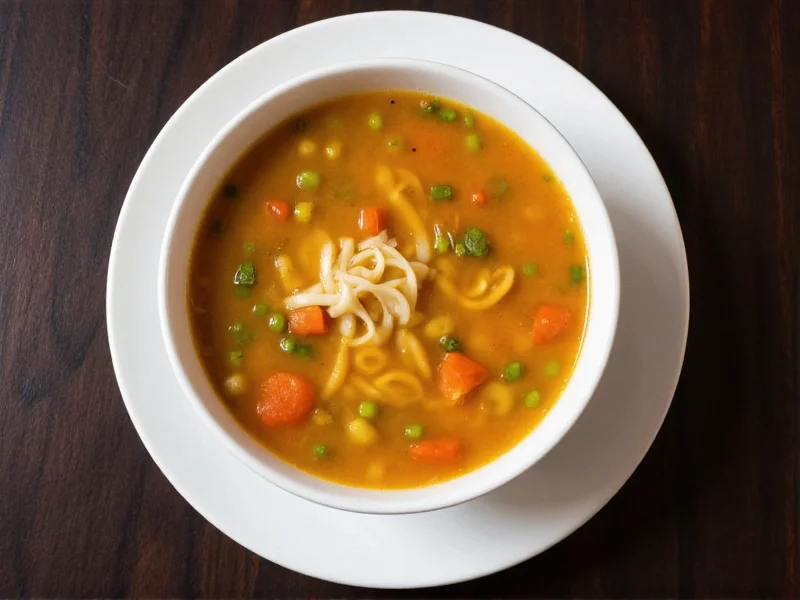When you search for "letter soup," you're likely encountering one of two very different concepts that share the same name. Understanding which meaning applies to your situation can help you find exactly what you need, whether you're looking for a children's educational activity, a recipe, or information about reading difficulties.
The Culinary Letter Soup: Alphabet Pasta
Alphabet soup represents the most common literal interpretation of letter soup. This popular children's food features small pasta pieces shaped like letters of the alphabet, typically served in broth. Originating in Italy as "pasta alfabeto," this educational food made its way to American tables in the early 20th century.
Manufacturers create alphabet pasta using durum wheat semolina, forming the dough into 26 letter shapes (sometimes including numbers too). When cooked properly and served in a light broth, children can pick out letters while eating, making mealtime both nutritious and educational. Many parents appreciate how this simple food product naturally encourages letter recognition without feeling like structured learning.
| Alphabet Soup Nutritional Profile (per 1 cup serving) | Amount |
|---|---|
| Calories | 80-100 |
| Protein | 3g |
| Carbohydrates | 15g |
| Fiber | 1g |
| Sodium | 400-600mg |
Creating Homemade Alphabet Pasta
While store-bought alphabet soup remains convenient, making your own letter-shaped pasta offers customization options. Home cooks can use cookie cutters to shape letters from fresh pasta dough, allowing for larger sizes perfect for young children. Some creative variations include:
- Using whole wheat or vegetable-infused dough for added nutrition
- Creating oversized letters for toddlers who might choke on standard sizes
- Adding food coloring to make letter recognition more engaging
- Forming letters from rice or quinoa for gluten-free alternatives
When preparing homemade alphabet pasta, cook the letters separately from the broth to prevent them from becoming mushy. Add them to the soup just before serving to maintain their shape and provide that satisfying "letter hunt" experience for children.
Letter Soup as a Linguistic Concept
Beyond the culinary meaning, "letter soup" describes text that appears as an indecipherable mixture of characters. This metaphorical usage often appears when discussing reading difficulties, particularly among children learning to read or individuals with dyslexia. When text appears jumbled or letters seem to move on the page, readers might describe it as looking like "letter soup."
Unlike actual dyslexia—which involves neurological processing differences—"letter soup" refers specifically to the visual experience of text appearing disorganized. This phenomenon can occur due to:
- Poor typography choices (low contrast, tiny fonts, cramped spacing)
- Visual stress or Irlen syndrome
- Temporary visual fatigue from screen reading
- Certain neurological conditions affecting visual processing
Educational Applications of Alphabet Soup
Educators have leveraged alphabet soup's dual nature for decades to create engaging learning experiences. The physical food product serves as a multisensory teaching tool that combines:
- Tactile learning (picking up pasta letters)
- Visual recognition (identifying shapes)
- Auditory connection (saying letter names)
- Motor skill development (manipulating small objects)
Teachers often design activities where children:
- Find specific letters in their soup
- Create their name with pasta letters
- Sort vowels and consonants into separate bowls
- Build simple three-letter words
These letter soup activities for preschoolers transform mealtime into valuable pre-literacy practice without children feeling like they're completing formal lessons. The edible nature of the materials adds an element of fun that traditional flashcards often lack.
Distinguishing Letter Soup from Related Concepts
Understanding the difference between related terms prevents confusion when researching this topic:
- Letter soup vs word soup: Letter soup refers specifically to individual characters appearing jumbled, while word soup describes entire words that seem to blend together without clear separation.
- Letter soup vs dyslexia: While some with dyslexia report seeing letter soup, the condition involves more complex processing challenges beyond visual appearance.
- Alphabet soup vs letter soup: In culinary contexts, these terms are interchangeable, though "alphabet soup" appears more frequently in product names.
Practical Tips for Using Letter Soup Concepts
Whether you're interested in the food or the linguistic concept, these evidence-based recommendations can help:
- For parents: Serve alphabet soup slightly cooled to prevent burns while maintaining letter integrity
- For educators: Pair physical letter manipulation with verbal identification to reinforce learning
- For designers: Avoid creating "letter soup" effects by ensuring adequate spacing and contrast in text layouts
- For individuals experiencing reading difficulties: Try colored overlays or specialized fonts if text appears as letter soup
Remember that while alphabet soup makes letter recognition enjoyable, it shouldn't replace comprehensive literacy instruction. Similarly, occasional experiences of text appearing as letter soup don't necessarily indicate a learning disability—context and frequency matter significantly.











 浙公网安备
33010002000092号
浙公网安备
33010002000092号 浙B2-20120091-4
浙B2-20120091-4